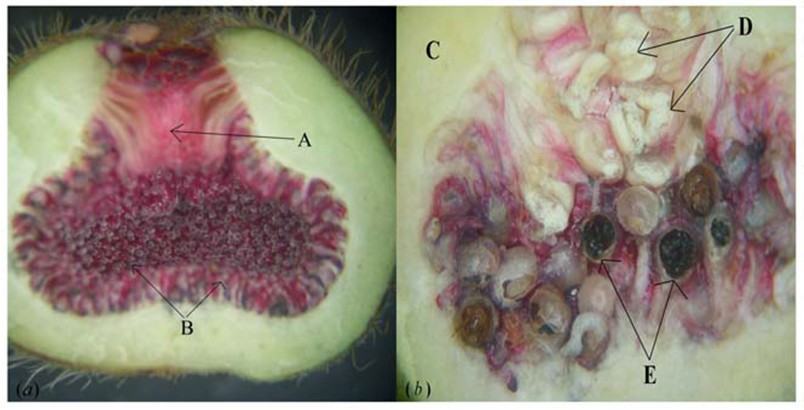

Figs are the inflorescences of fig trees (Ficus spp. Moraceae). They are shaped like a hollow ball, lined on their inner surface by numerous tiny female flowers. Pollination is carried out by host-specific fig wasps (Agaonidae). Female pollinators enter the figs through a narrow entrance gate. They lay their eggs into the ovules, via the stigmas and styles, and also gall the flowers, causing the ovules to expand and their pedicels to elongate. A single pollinator larva develops in each galled ovule. Numerous species of non-pollinating fig wasps also make use of galled ovules in the figs. Some initiate galls, others make use of pollinator-generated galls, killing pollinator larvae. Most NPFW oviposit from the outside of figs, making peripherally-located pollinator larvae more prone to attack.
Style length variation is high among monoecious Ficus spp. and pollinators mainly oviposit into more centrally-located ovules, with shorter styles. Style length variation is lower in male (wasp-producing) figs of dioecious Ficus spp., making ovules equally vulnerable to attack by NPFW at the time that pollinators oviposit. How the pollinator wasps in dioecious figs to avoid the negative affection of the non-pollinators? Dr. YU Hui in South China Botanical Garden and her co-operator (Dr. Stephen G. Compton; University of Leeds) studied the spatial distributions of galled ovules in mature male figs of the dioecious Ficus hirta in Southern China. The results show that: 1. the galls contained pollinators and three NPFW that kill them; 2. Pollinators were concentrated in galls located towards the centre of the figs, NPFW towards the periphery; 3. Due to greater pedicel elongation by male galls, male pollinators became located in more central galls than their females, and so were less likely to be attacked. This helps ensure that sufficient males survive, despite strongly female-biased sex ratios, and may be a consequence of the pollinator females laying mostly male eggs at the start of oviposition sequences.
The study has been adopted by PLOS ONE, 2012, 7(1): e30833.

Male figs of Ficus hirta: (a) female phase fig, male flowers around the ostiole and short-styled female flowers inside the fig;(b)male phase fig, symbiotic wasps including pollinators and non-pollinators nearly to be adults.

